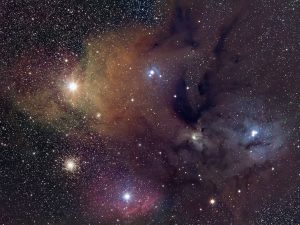The brightness of a star depends on its temperature. Combined with the star’s chemical composition this will determine its so-called “stellar spectra”.

The first attempt to classify stars based on their stellar spectra was made by an Italian astronomer (and scientific adviser to the Pope), Father Pietro Angelo Secchi. He divided spectra into three classes:
- Class I White stars having strong hydrogen lines, such as Vega (Alpha Lyrae).
- Class II Yellow stars having strong metallic lines, such as Arcturus (Boötes).
- Class III Red stars having broad, fluted bands of molecules such as titanium oxide, such as Antares (Alpha Scorpii).
By 1900 this classification had been extended by the Harvard College Observatory to provide for six spectral types, namely B, A, F, G, K and M. Later the system was further expanded to add W and O types before type B, and to subdivide G and K, to create the following schema:
| Stella Spectra | |||||||||
|---|---|---|---|---|---|---|---|---|---|
| Type | W | O | B | A | F | G | K | M | D |
| Side branches | C N O | C R N | S | ||||||
| Age | Youngest | Oldest | Deceased | ||||||
| Lifespan | Short | Long | |||||||
| Temperature | Hottest | Coolest | |||||||
| Blue | Red | ||||||||
| Note that 99% of all stars fall into the B to M type range | |||||||||
The reason the types are not in alphabetical order is simply historical. It started out that way (A-M), but with continual discoveries the list had to be extended as you see above, being the temperature sequence of spectral types of stars with “W” and “O” representing the hottest stars and “M” the coldest stars.
Type D stars are “dead stars”, white dwarfs that are no longer producing energy. They have an estimated age range of 100 000 years to 10 billion years. They are small, often less than the size of Earth, but extremely dense, with temperatures ranging from around 7 700°C to 40 000°C. Neutron stars are also Type D.
You might need a mnemonic to remember the correct order—just remember “W” now comes first. It stands for Wolf-Rayet, by the way, and these massive stars are very rare. So try: Oh Be A Fine Girl and Kiss Me Dead!
So why is blue hot? After all we tend to think of red as being hot—think of sunburn or think of passion; and blue being cold (your lips or fingers turn blue when cold). But in space life is very different where the colours are based on the wavelength of light. The energy in a photon depends on its wavelength: the shorter the wavelength the more energetic the photon (so it looks blue); the longer the wavelength the less energetic the photon (so it looks red). This is why blue stars are “hot” and red stars are “cool”.
| Properties of each star type | ||||
|---|---|---|---|---|
| Spectral type | Temperature °C | Prominent spectral lines | Colour | Example |
| W | 30 000 - 210 000 | Ionised helium and highly ionised nitrogen and carbon | Blue | (no-name brand) |
| O | 25 000 - 40 000 | Ionised helium; oxygen, nitrogen, carbon and silicon | Blue | Regor |
| B | 11 000 - 25 000 | Helium and some hydrogen, carbon, oxygen, nitrogen, iron and magnesium | Bluish-white | Rigel |
| A | 7 500 - 11 000 | Strong hydrogen, some ionised metals such as calcium | White | Sirius |
| F | 6 000 - 7 500 | Hydrogen, ionised calcium and iron | Yellowish-white | Procyon |
| G | 5 000 - 6 000 | Calcium, iron, titanium, magnesium, hydrogen and some molecular bands | Yellow | Sun |
| K | 3 500 - 5 000 | Calcium, hydrogen, some sodium. and molecular bands such as titanium oxide | Orange | Alderbaran |
| M | 2 500 - 3 500 | Strong titanium oxide, very strong sodium, calcium and molecular bands | Red | Antares |
| See text for further details; some of the elements are ionised particles | ||||
By Nigel Benetton, science fiction author of Red Moon Burning and The Wild Sands of Rotar.
Last updated: Thursday, 18 March 2021